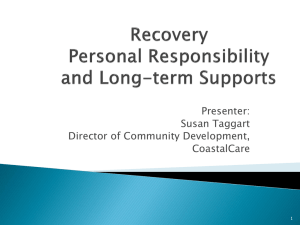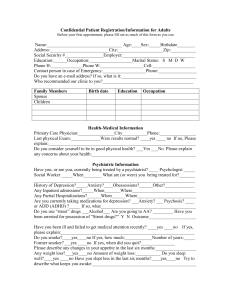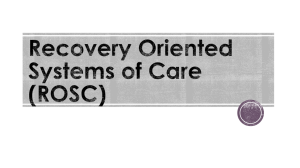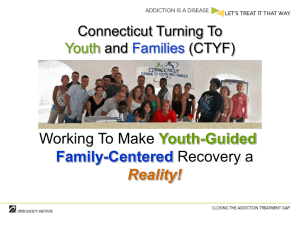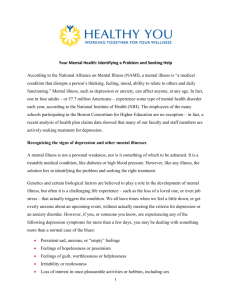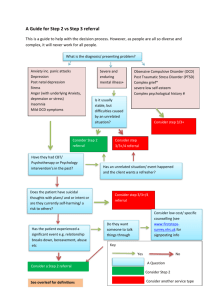National Recovery-Oriented Mental Health Practice
advertisement
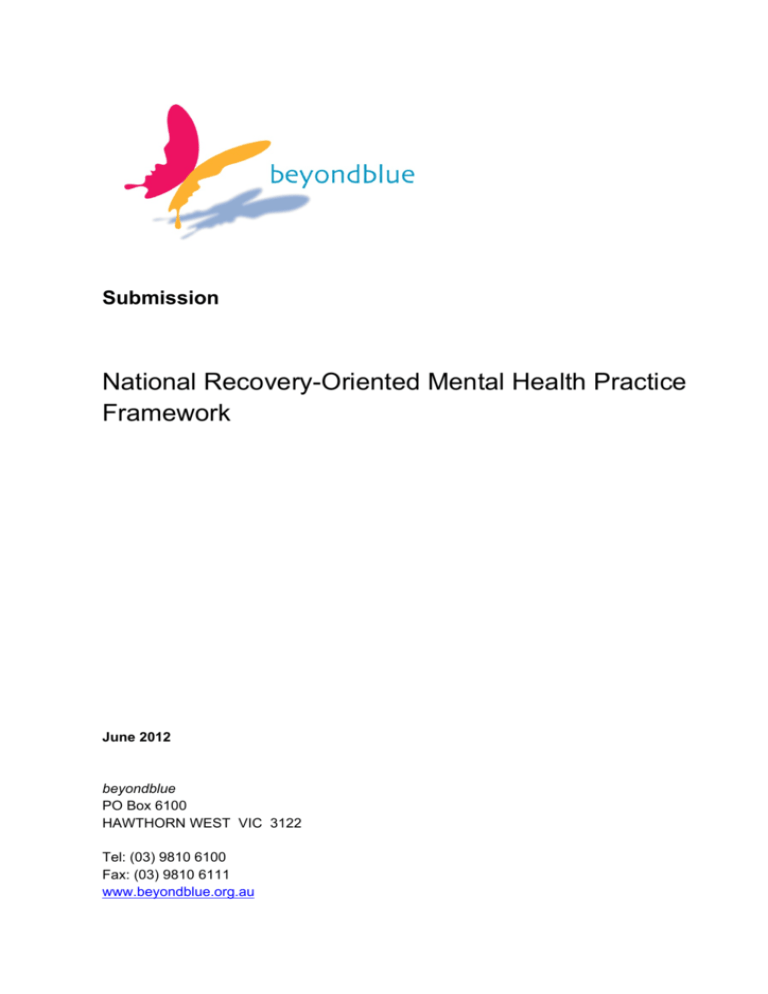
Submission National Recovery-Oriented Mental Health Practice Framework June 2012 beyondblue PO Box 6100 HAWTHORN WEST VIC 3122 Tel: (03) 9810 6100 Fax: (03) 9810 6111 www.beyondblue.org.au National Recovery-Oriented Mental Health Practice Framework beyondblue beyondblue, the national depression and anxiety initiative, is pleased to present this submission on the National Recovery-Oriented Mental Health Practice Framework to Craze Lateral Solutions. In making this submission, beyondblue has focussed on the high prevalence mental health disorders of depression and anxiety, the impact on consumers and carers, and areas that are most relevant to our work and research findings. beyondblue is a national, independent, not-for-profit organisation working to reduce the impact of depression and anxiety in the Australian community. Established in 2000, beyondblue is a bipartisan initiative of the Australian, State and Territory Governments. beyondblue works in partnership with health services, schools, workplaces, universities, media and community organisations, as well as people living with depression and anxiety, to bring together their expertise. Our five key result areas are: 1. Increase awareness of depression and anxiety 2. Reduce stigma and discrimination 3. Improve help seeking 4. Reduce impact and disability 5. Facilitate learning, collaboration, innovation and research Specific population groups that beyondblue targets include young people, Indigenous peoples, people from culturally and linguistically diverse backgrounds, people living in rural areas, gay, lesbian, bisexual, trans and intersex populations, and older people. Prevalence and impact of depression and anxiety disorders Depression, anxiety and substance use conditions are the most prevalent mental health disorders in Australia.1 One in three Australians will experience depression and/or anxiety at some point in their lifetime and approximately 20 per cent of all Australians will have experienced depression, anxiety or a substance use disorder in the last year.2 People experiencing depression and/or anxiety are also more likely to have a co-morbid chronic physical illness.3 Mental illness is the leading cause of non-fatal disability in Australia, and it is important to note that depression and anxiety accounts for over half of this burden.4 Globally, the World Health Organization predicts depression to become the leading cause of burden of disease by the year 2030, surpassing ischaemic heart disease.5 Mental illness costs the community in many different ways. There are social and service costs in terms of time and productivity lost to disability or death, and the stresses that mental illnesses place upon the people experiencing them, their carers and the community generally. There are financial costs to the economy which results from the loss of productivity brought on by the illness, as well as expenditure by governments, health funds, and individuals associated with mental health care. These costs are not just to the health 1 sector but include direct and indirect costs on other portfolio areas, for example welfare and disability support costs. It is estimated that depression in the workforce costs the Australian society $12.6 billion over one year, with the majority of these costs related to lost productivity and job turnover.6 The individual financial costs are of course not exclusively borne by those with mental illness. It is often their carers who experience financial hardship due to lost earnings, as well as increased living and medical expenses.7 beyondblue’s response to the National Recovery-Oriented Mental Health Practice Framework – 1st consultation draft Recovery concepts in mental health practice and service delivery Question 1: Has this section clarified how recovery concepts are used and understood in this framework? The draft Framework provides a broad overview of the concept of recovery. It is important that recovery is presented as an holistic and inclusive approach. The views and experiences of people with a mental illness vary significantly, based on the duration, type and severity of their illness, along with their cultural background and personal identity (including factors such as language, worldview, cultural practices, gender and sexual identity, and past experiences of trauma). The principles of recovery should acknowledge, embrace and affirm these diverse experiences, and support service providers to deliver care in culturally safe environments. Within the recovery concept, there is also an opportunity to provide additional information on the role of partnerships. Partnerships are reflected in the Framework’s proposed domains of practice; however it is important that this focus is integrated throughout the whole document. Partnerships may be an essential component of recovery, as they provide a mechanism to support the individual with a mental illness, and their family, friends and community, to link with other service providers and social support organisations (for example, housing, employment, education services). While additional information to support the concept of recovery is needed, this needs to be balanced with the intended audience and purpose of the Framework. To be implemented successfully, it is essential that a clear and succinct definition of recovery and its core components and principles are provided, along with information on what recovery means for both people with a mental illness and their families and friends, and service providers. Recommendations 1. Update the proposed recovery concept to include: an acknowledgement and affirmation of the diverse characteristics of the Australian society, including diversity in language, worldview, cultural practices, gender and sexual identity, and experiences of trauma (for example, from experiences of migration, transgenerational trauma, the Stolen Generation). 2 a focus on services providing culturally safe environments. a focus on partnerships. 2. Develop a clearer and more succinct overview of the recovery concepts, that can be easily utilised by service providers. This may include links to additional resources for a more in-depth understanding of recovery. 3. Develop practical examples of applying the recovery concepts in mental health, to demonstrate how service providers and policy makers can adopt and integrate the concepts of recovery into their practice. Recovery Processes Question 2: Glover’s five point Star of Recovery comprise the dichotomies of passive sense of self/active sense of self; hopeless/despair; other’s control/personal control and responsibility; discovery/alienation; connectedness/disconnected. Does this model assist understanding recovery processes as well as practices that can support a person’s recovery efforts? Glover’s five point ‘Star of Recovery’ provides an example of recovery processes. However, to increase understanding of recovery, the range of recovery processes, and how it can be supported in practice, it is important that the Framework draws on a broad range of models, recovery research and personal experiences. While information on the theoretical underpinnings of recovery may assist in understanding the components of recovery, to change practice, it is essential that this information is translated into practical, evidence-informed resources and tools, that service providers can easily adopt in everyday practice. The information on recovery processes could be strengthened by considering: The relationship between the determinants of mental illness (for example, experiences of stigma and discrimination, poor housing, unemployment), treatment outcomes and recovery processes. Reframing the ‘barriers to recovery’ to ensure that they are not presented as necessarily leading ‘to the formation of disability’ (page 31). While these barriers may impact on recovery processes, service providers should have a role in addressing and incorporating these experiences into recovery-oriented practice. Additional barriers that could be considered in the Framework include the Stolen Generation; migration outcomes; the heteronormative nature of society; and denial of identity, including gender, sexual and cultural identities. Recommendations 4. Utilise a broader range of research, recovery models and personal experiences to increase understanding of recovery processes. Information on the theoretical underpinnings of recovery should be included as a supporting document, rather than being included in the Framework. 5. Develop practical information on how service providers can support and implement the recovery processes. This should recognise and respond to the determinants of mental health. 3 6. Reframe the barriers of recovery to ensure that they are not presented as factors that will lead to the ‘formation of disability’. Recovery in the spectrum of mental health services Question 3: Has the relationship between recovery practice and service delivery and other mental health interventions been adequately described? Would you suggest any changes? The Framework provides a description of the spectrum of mental health services. However, the relationship between each stage of mental health service delivery, and recovery-oriented practice, has not been adequately described. To help ensure that the Framework informs mental health care, there should be: A description, practical examples, and tools to assist service providers to deliver recovery-oriented practice, across the spectrum of services (for example, checklists, case studies, audit tools etc). Information and tools on how service providers can partner with organisations addressing the social determinants of mental health (for example, housing, unemployment services, human rights), to ensure that holistic services are provided which support the recovery process. Information and tools on how to adapt the Framework to incorporate the needs of local communities and ensure that the diverse characteristics of the Australian society are embraced and inform service delivery. Recommendations 7. Include a description and practical examples of how recovery-oriented practice should be implemented across the spectrum of mental health services. 8. Develop practical tools to assist service providers to implement recovery-oriented practice; partner with organisations; and adapt the Framework to meet the needs of local communities. Supporting recovery in a diverse Australia Question 4: In relation to each or any of the population groups discussed, are there any further issues or challenges that need to be addressed in ensuring the relevance of the recovery-oriented practice framework? Indigenous Australians The Framework recognises the importance of understanding the diversity of Aboriginal and Torres Strait Islander peoples’ experiences, values and conceptions of mental health and wellbeing. This understanding is a fundamental component of delivering culturally appropriate and effective recovery-oriented care. The Framework could be strengthened by acknowledging the importance of adjusting the physical environment of service delivery, to ensure that recovery-oriented services are delivered in an appropriate way (for example, meeting in larger rooms to ensure that an individual’s family and support people can attend). 4 It is also important that the Framework recognises the impact of the Stolen Generation policies and practices, including being removed from one’s family, community and Land, occurred among people from remote, regional and urban communities. While the Framework acknowledges that rural and remote Aboriginal and Torres Strait Islander people may experience distress leaving their Country to receive mental health treatment and services, this acknowledgement should also be extended to people living in urban communities. The ‘Welcome to Country’ from an Elder is a traditional practice across Aboriginal and Torres Strait Islander urban, rural and remote communities. It is important and culturally appropriate that Aboriginal people are ‘welcomed’ to the Land on which they receive mental health services. A practical example of how this could be achieved may be the development of resources, such as a DVD or poster, which includes a local Elder welcoming people to Country and walking a person through how the service operates and what they should expect. This may help to ensure that recovery-oriented services are culturally appropriate and safe. The Framework should also support the development of local recovery-oriented practice models that both reflect best-practice approaches, as well as the needs of local communities. The ‘Beat practice in Early intervention, Assessment and Treatment of depression and substance misuse’ (BEAT) project, being delivered by the Menzies School of Health Research, with funding from beyondblue and the Northern Territory Department of Health and Families, may provide important learnings and insights on how to develop healthcare pathways and service delivery practices, that reflect both a best-practice approach, as well as the needs of individual communities. These learnings could be integrated into the Framework, to help ensure that services provide appropriate and effective care that responds to the needs of Indigenous Australian communities. Recommendations 9. Develop practical guidelines and tools for service providers on how to provide culturally appropriate and safe services, that meet the needs of Indigenous communities (for example, adjusting the physical environment of consulting rooms; ‘Welcome to Country’ by an Elder for people with a mental illness and their family and community to the Land). 10. Provide recommendations on how services can develop local recovery-oriented practice models that both reflect best-practice approaches, as well as the needs of local communities. The learnings from the ‘Beat practice in Early intervention, Assessment and Treatment of depression and substance misuse’ project could inform the development of these practical guidelines and recommendations. Culturally and linguistically and other diverse (CALD) populations The Framework’s focus on culturally sensitive and responsive recovery-oriented practice is essential to service providers delivering appropriate and effective care for people from CALD populations. Integrating components of Multicultural Mental Health Australia’s National Cultural Competency Tool8 into the recovery Framework (currently a reference document within the Framework) may help to ensure that the important components of culturally sensitive practice is reflected in the Framework’s capabilities, and implemented by service providers. It is also important that the Framework acknowledges the time required to build 5 relationships with CALD populations, and provides information and tools on how to create local relationships and partnerships with communities. Recommendations 11. Develop practical tools and guidance for service practitioners on how to provide culturally sensitive and responsive recovery-oriented services, focusing on the development of local relationships and partnerships, and drawing on the Multicultural Mental Health Australia’s National Cultural Competency Tool. Lesbian, gay, bisexual, transgender and intersex (LGBTI) people The Recovery Framework provides an important opportunity to increase the skills and capacities of service providers to deliver inclusive and comprehensive services for LGBTI populations. While the Framework acknowledges that LGBTI populations experience higher rates of mental health problems that the general population, and there is a compounding effect of discrimination for LGBTI populations, it is important that this acknowledgement translates into improved service delivery. Mental health services would benefit from receiving training and education to improve their knowledge of the impact of discrimination, and how to develop more inclusive policies, procedures and attitudes, including appropriate standards of care (for example, for transsexual clients undergoing physical transition to be treated in accordance with their affirmed gender). This education and training should acknowledge the diversity of LGBTI populations, and the importance of not adopting a homogenised approach within the service delivery environment. There is a tendency in health service delivery to treat people of diverse sexualities, diverse gender or diverse sex as one group. There is evidence that risk and protective factors differ between groups (for example, emotional and/or physical abuse, sexual abuse and unwanted sexual activity are more prevalent among bisexual women than homosexual women).9 Information on diverse experiences should also reflect the different needs of LGBTI populations across the lifespan. The Recovery Framework acknowledges the role of peer-based services as a component of recovery. While inclusiveness among mainstream recovery-oriented services is a priority, mainstream models may not always be appropriate. Opportunities for LGBTI peer-based recovery should also be supported, particularly where people have experienced high levels of discrimination and would benefit from mental health support within an LGBTI context. The implementation of inclusive services could be informed by Gay and Lesbian Health Victoria’s (GLHV) ‘Rainbow Tick’ program. GLHV is currently working with a standards agency to develop an accreditation process for LGBTI inclusive practice in Australia.10 While the implementation of the Recovery Framework could adopt a similar process, in which service providers are accredited for delivering recovery-oriented services, within LGBTI populations specifically, there may be important resources and practical tools developed through the Rainbow Tick program that could be adapted for the recovery Framework. beyondblue has recently published a Position Statement on Depression and Anxiety in GLBTI populations (see Attachment A). The research presented in this Position Statement, 6 and the recommendations to improve social inclusiveness and mental health outcomes, could also inform the recovery Framework. Recommendations 12. Develop practical tools and guidelines for service providers on how to deliver inclusive services for LGBTI populations, including inclusive policies, procedures, attitudes, and standards of care. This should be supported through education and training programs. 13. Adopt the learnings from the Gay and Lesbian Health Victoria’s development and implementation of the ‘Rainbow Tick’ program. Children, young people and emerging adults It is important that mental health services provide recovery-oriented care, that meets the developmental needs of children and young people. Recovery-oriented care should focus on providing services and support to the family unit, rather than an individual child and/or parent. This care should recognise that many children with mental health problems have had adverse family experiences (for example, abuse, neglect, parental conflict and separation/divorce), while some children have experienced trauma that does not relate to their family functioning. In addition to responding to these diverse family experiences, care should also be culturally appropriate and sensitive, incorporating the particular needs of families from Aboriginal and Torres Strait Islander backgrounds, and CALD communities. Providing care to children, young people, and their family, should be done in nonstigmatising and non-threatening settings. This holistic care should be delivered across settings (for example, family environment, education, clinical care), and include a strong focus on retention in education. It is important that an individual’s support network is aware of an individual’s preferred help-seeking behaviour, and can support the recovery process. The Framework should therefore incorporate a focus on the role of those individuals in close contact with the young person (for example, school counsellors, teachers). It is also essential that recovery-oriented care responds to the child or young person’s developmental stage, acknowledging that some changes in development, such as puberty, may not align with emotional and social development. Recovery-oriented services for young people should provide the individual with the autonomy to control their recovery process and goals; the ability to prioritise their needs; and to receive treatment in a staged approach. Providing children and young people with autonomy appropriate for their level of development, while supporting them with streamlined case management, will help to build the resilience and capacity of young people to manage their mental health. Recommendations 14. Develop practical tools for service providers on how to deliver holistic, family-based care to children and young people. 15. Include the role of educational providers and support services in the recovery Framework, to ensure that a young person’s recovery processes and goals are supported across settings. 7 Older people There is an important role for recovery-oriented services in improving the quality of life of older people experiencing mental health problems. However, to ensure that services and settings working with older people deliver recovery-oriented care, the language and concepts of recovery may need to be adapted to different environments. For example, in aged care facilities the term ‘recovery’ may not be commonly utilised or seen as appropriate, however adopting terms and concepts that are meaningful for staff in these environments, such as a focus on ‘person-centred care’, ‘positive ageing’, and ‘ageing well’, may be more appropriate, and help in the implementation of the recovery concepts. Recovery-oriented approaches relating to older people also need to consider the two-way nature of the links between chronic disease and mental health conditions (particularly depression). There are good reasons to prioritise management of mental health issues in older people given their impact on physical health outcomes and overall quality of life. In turn, chronic disease can be a risk factor for mental health issues such as depression – for more information on this relationship, see the response to Question 5. For some older people, such as those experiencing dementia, there may be a limited capacity to participate in the recovery process. Family and close friends can play a role in such situations. The Framework should therefore ensure that it is applicable to different environments, and service providers can adjust their understanding and delivery of recovery-oriented care to respond to these challenges. To be effectively implemented, the Framework should also be supported through work that addresses the stigma about ageing. Health professionals and the broader community may hold stigmatising attitudes on ageing, that may impact on treatment and recovery processes and outcomes. Education and training programs that increase the capacity and skills of staff in aged care to deliver recoveryoriented care, should therefore also address potentially stigmatising attitudes, to ensure that these views do not negatively impact on treatment and the recovery process. While the Framework acknowledges the importance of adjusting recovery-oriented services to respond to the needs of older people from Aboriginal and Torres Strait Islander communities, CALD communities, people living in rural and remote communities, those in insecure housing, and older people in the justice system, there is also a need to focus on the particular needs of older LGBTI people. Qualitative research with older LGBTI Victorians living in aged care has suggested that there are a number of key themes and challenges experienced by older LGBTI people. These include the impact of current and historical experiences of discrimination; the impact of identity concealment; ‘invisibility’ of LGBTI populations in residential and health care settings; the impact of inadvertent visibility; and inadequate standards of care.11 The recovery Framework’s focus on the needs of both older people, and LGBTI populations, should incorporate an explicit focus on older LGBTI populations, to ensure that appropriate and safe recovery-oriented care is provided. Recommendations 16. Ensure that the recovery Framework can be adjusted to meet the needs of different service environments, including aged care settings. Adjust the language of the recovery Framework to meet the needs of different service environments. 8 17. Support training and education programs that increase the skills and capacity of aged care service providers to deliver recovery-oriented care, incorporating a focus on stigmatising ageist attitudes, and the needs of specific population groups, including LGBTI populations. Rural and remote communities People living in rural and remote communities may experience particular challenges in accessing mental health care and participating in the recovery process. There is significant diversity within and between rural, regional and remote communities. It is important that the recovery Framework adopts a flexible approach that incorporates the needs of local communities. Within rural, regional and remote communities in particular, there is a strong role for service coordination and integration to improve access to recovery-oriented services. An example of an effective program which increased service coordination is the beyondblue, Australian General Practice Network, and Divisions of General Practice program, the Mental Health in Drought Affected Communities Initiative (2007 – 2011). This initiative aimed to develop community capacity and resilience in drought affected communities. Central to the success of this program was the role and function of Community Support Workers, who were based in Divisions of General Practice, and performed outreach services; networking and brokerage between service providers; and crisis intervention. The evaluation of this initiative concluded that “the role of the Community Support Worker has been fundamental to building awareness and creating greater access to mental health information, training and support services to organisations, businesses and individuals experiencing or at risk of environmental threats, such as the drought.” 12 To ensure that people living in rural, regional and remote communities can actively participate in recovery and be supported by their health professionals, it is important that there is an increased focus on service providers delivering integrated and coordinated care. This care should build on the strengths of communities, and link with centralised services (for example, telephone counselling services, e-health programs), to help overcome some of the barriers to accessing care outside of metropolitan regions. Recommendations 18. In the implementation of the recovery Framework, include strategies that improve the service coordination and integration of recovery-oriented services in rural, regional and remote communities. The beyondblue, Australian General Practice Network and Divisions of General Practice program, Mental Health in Drought Affected Communities Initiative, is an example of an effective strategy implemented specifically in rural and remote communities. Parents with mental illness and their children The recovery Framework should incorporate special considerations for the delivery of recovery-oriented care to parents with a mental illness. In accordance with the United Nations Convention on the Rights of the Child, the best interests of the child should be 9 the primary consideration in delivering mental health care to parents.13 Identifying parental status, and developing and implementing family-unit assessments and intervention services, are important to protect and promote the wellbeing of parents and their children. Familyfocused recovery-services, which integrate mental health care and child and family care, is an essential component of providing best practice care for parents and their children.14 The recovery Framework should incorporate tools and guidelines to assist service providers to deliver family-focused care. In addition to considering the role of the family in the delivery of recovery-oriented treatment, the Framework should also incorporate a specific focus on mothers and their partners during pregnancy and in the early postnatal period. Research indicates that there is a significant impact of untreated mental illness on the development of a foetus and the early months of a child’s life.15,16,17 Recovery-oriented services being delivered to this population group should therefore include the provision of evidence-informed information to women and their families, and the delivery of specific treatment and recovery services which take into account the infant and family’s ability to provide care for the infant. To assist health professionals to accurately identify and treat mental health problems during pregnancy and the first postnatal year, beyondblue developed the Clinical Practice Guidelines for Depression and Related Disorders – anxiety, bipolar disorder and puerperal psychosis – in the perinatal period. These Guidelines, endorsed by the National Health and Medical Research Council, have informed the development of a suite of information resources for health professionals and women in the perinatal period and their partners, including: An online, free and accredited training program for health professionals - beyond babyblues: detecting and managing perinatal mental health disorders in primary care (www.thinkgp.com.au/beyondblue) Perinatal health professional resources and tools based on the Clinical Practice Guidelines, including an Executive Summary of the Guidelines, and assessment and management fact sheets and tools. Resources for women and their partners and families in the perinatal period, including booklets on Emotional health and wellbeing during pregnancy and early parenthood and Managing mental health conditions during pregnancy and early parenthood. The recovery Framework should draw on these existing tools and resources, to ensure that health professionals working with women and their families in the perinatal period deliver recovery-oriented services that are in line with best-practice approaches. Recommendations 19. Integrate existing beyondblue-developed information, tools and guidelines for health professionals into the recovery Framework and its supporting resources, to assist in the delivery of family-focused, best practice care for parents with a mental illness and their children. 10 Question 5: Are there any further population groups whose particular needs and circumstances require consideration? If so what particular issues and challenges need to be addressed by the framework? The Framework acknowledges that there is a need to consider people in forensic and youth justice settings; and people with co-morbid and/or complex needs. To inform the development of guidelines and practical resources to assist service providers to deliver recovery-oriented care in criminal justice settings, research and consultation with this sector is required. There is a strong relationship between chronic physical illnesses and mental illnesses. Research indicates that: 28 per cent of people with a chronic physical condition also have a mental disorder18 Having a chronic physical illness puts a person at greater risk of developing depression19 Depression also increases the likelihood of developing a chronic physical illness, particularly heart disease, stroke and diabetes.20 The recovery framework should support health care services to provide coordinated and integrated care, that considers the relationship between co-morbid illnesses, and how this may impact on recovery processes and goals. The Framework should therefore also be implemented within settings focusing on the delivery of chronic illness healthcare services, to ensure that all health professionals support individuals in their recovery. There is also a need for the recovery Framework to consider the complex and interrelated relationship between mental illness and alcohol and drug misuse. This relationship is explored by Frei and Clarke (2011), 21 who indicate that: addictive substances exacerbate psychiatric symptoms people experiencing depression and anxiety may use psychoactive drugs to manage symptoms active substances may induce psychiatric disorders substances may substantially impact the effectiveness of psychiatric pharmacotherapies. Health care providers need to have the skills and capacity to deliver recovery-oriented services to people with co-existing mental illnesses and alcohol and drug misuse problems. The recovery Framework should therefore provide practical tools and information on integrated and coordinated service delivery, across mental health and drug and alcohol services, which is supported through education and training. The Framework should also consider the needs of people with a physical disability, an intellectual disability and people with communication difficulties. The information and tools needed to support providers to deliver care to these population groups should be developed in consultation with relevant stakeholders. 11 Recommendations 20. Consult with stakeholders in the criminal justice system and disability services to develop information and practical tools on the particular needs of people with a mental illness in the justice system, and people with a mental illness and co-existing physical and intellectual disabilities and/or communication difficulties. 21. Include information and tools to support the delivery of integrated and coordinated care for people with a mental illness and co-existing chronic physical illnesses, and alcohol and drug misuse problems. 22. Include a focus on the role of service providers working within chronic illness and drug and alcohol services within the recovery Framework, which is supported through education and training programs. Practice domains and key capabilities Question 6: What is your response to the suggested practice domains and key capabilities? Would you suggest any changes? The proposed domains of practice - working relationships; promoting citizenship; organisational commitment; and supporting personally defined recovery – are appropriate and applicable to all levels of service delivery. The key capability of the working relationships domain could be strengthened by: Incorporating a focus on delivering family-based care, as well as working with families and personal support networks. For some population groups, such as children and young people, parents with a mental illness, and some cultural groups, the delivery of family-unit care, rather than individual care, may be more appropriate and effective. The key capabilities should therefore reflect this model of service delivery. Including a stronger focus on the development of meaningful engagement and therapeutic relationships with communities. For some population groups, such as CALD and Aboriginal and Torres Strait Islander communities, there is a need to develop a relationship not only with the individual and their family/carer(s) and other service providers, but also with the community. This process may help to ensure that services are culturally appropriate and delivered in safe environments. The capabilities within the promoting citizenship and connectedness domain could be improved by: Increasing the focus to working with first Australians and other population groups. There is a diverse range of population groups and understandings of recovery that should be promoted and supported through the Framework. Expanding the focus on social inclusion and community participation to also recognise the role and importance of participation in employment and education. 12 The capability of organisational commitment is an essential component of ensuring that the policies and practices of services support individuals to participate in recovery processes. Practical tools and guidelines will need to be developed to support the proposed capabilities of organisational culture, service partnerships, and workforce development and planning. This capability should also incorporate a focus on how service providers should partner with agencies addressing the social determinants of mental health, to ensure that holistic care is provided, that is appropriate to the circumstances of an individual’s life. The supporting personally led recovery domain and capabilities are vital to empowering individuals to participate in the recovery process. The proposed capabilities could be strengthened by including a focus on promoting personal identity, together with autonomy and self-determination; and being responsive to and inclusive of diversity in sex and sexuality. Recommendations 23. Update the working relationships domain to incorporate a stronger focus on familyfocused care; and the development of relationships with communities. 24. Expand the foci of the promoting citizenship and connectedness domain to include working with first Australians and other population groups; and to recognise the role and importance of participation in employment and education. 25. Update the organisational commitment domain to include a focus on the role of service providers in understanding and responding to the social determinants of mental health. 26. Incorporate a focus on personal identity, and diversity of sex and sexuality, in the supporting personally led recovery domain. Question 7: What should be the core principles, behaviours, attitudes, skills and knowledge for each capability? Are you able to suggest any examples of good leadership for any of the capabilities? Are you able to suggest any examples of good practice for any of the capabilities? Recommendations made throughout this submission should inform the development of the core principles, behaviours, attitudes, skills and knowledge for each capability. These should be further developed with people with a personal experience of mental illness and their families, friends and communities, together with service providers and relevant experts. Question 8: How might the domains and capabilities ensure relevance, to diversity and, across the lifespan? See recommendations and responses to Questions 4 and 5. Implementation and measuring progress Questions 9 and 10: What suggestions do you have as to how the Commonwealth, state and territory governments, mental health services and people with lived experience and their 13 families might collaborate to ensure practice and service development become more recovery-oriented? What principles should guide mental health services in deciding how to measure their progress in increasing their recovery-orientation? To influence service delivery, it is essential that there is a comprehensive and well resourced plan to implement the recovery Framework. This plan should consider ideas and factors such as: Supporting consumer and carer leadership – to ensure that recovery continues to be owned and led by consumers, it is essential that the implementation of the Framework provides opportunities and support for consumer and carer leadership (for example, consumers and carers could adopt central roles in determining how to adapt the Framework to meet the needs of their local community). This should be facilitated through Medicare Locals. Supporting organisational and system-level change management – to be successfully implemented, some services and systems will need to change their culture of practice. The implementation of the Framework should provide support to organisations to change their culture, processes, systems and governance arrangements, to support recovery-oriented practice. This should include a strong focus on embedding consumer and carer leadership within services. Supporting the implementation of the framework through Medicare Locals – there is a significant opportunity for Medicare Locals to manage the local adaptation and implementation of the recovery Framework within their communities, and providing a mechanism to support consumer and carer leadership. Developing training and education programs – some health professionals, particularly those working outside the mental health sector, may not be familiar with the concepts and processes of recovery. A comprehensive, ongoing and well resourced education and training program is therefore required to ensure that all individuals that are expected to implement the recovery Framework have the skills and confidence to do so. Integrating this training and education program into profesional development requirements would also provide an additional incentive to ensure that service providers participate in the training and education program. Developing practical implementation materials – resources and tools are needed to support service providers to implement the Framework, and adapt it to the needs of their local community. Materials such as service audit tools, guidelines for intake, and case studies, would be valuable resources that may help in the local delivery of services. Integrating the Framework with accreditation standards – working with accreditation providers to integrate the recovery Framework into standards that mental health services are accredited with, provides an opportunity to not only improve the delivery of recovery-oriented care, but also improve services across the assessment, diagnosis and treatment spectrums. Linking Government mental health funding with compliance with the Framework – integrating compliance with the Framework into Commonwealth, State and Territory Government-funded services will help to ensure that the Framework is delivered as intended, outcomes are measured, and ongoing improvements are 14 made. There are also opportunities to link the implementation of the Framework with other Government-funded health services. In some settings, such as aged care, mental health services are only provided to people with severe mental illnesses. Implementing the Framework across the spectrum of mental health services is therefore difficult. To address this problem, and to help ensure the delivery of integrated and coordinated recovery-oriented care, compliance with the Framework could be tied to other health and support services that work with people with a mental illness and their families and friends. Linking performance management processes with compliance with the Framework - integrating compliance with the Framework into Key Performance Indicators and the performance management processes and targets for relevant public service staff and government-funded service delivery organisations may increase compliance and accountability for the delivery of the Framework. It is important that compliance with the Framework focuses on the processes a service undertakes to support a person’s recovery. Linking performance management with improvements in a consumer’s clinical and non-clinical outcomes may not support the recovery principles and practices, which must be led by consumers, and undertaken over time. Developing and implementing an evaluation framework – clear measures are needed to demonstrate how the Framework is supporting people with a mental illness and their families and friends, in their recovery process. These measures should be developed with people with a mental illness and their families, friends and local communities. They should also be incorproated into existing reporting processes (such as the current development of the National Report Card on Mental Health and Suicide Prevention). Linking the Framework with other health reforms and centralised services – there are opportunities to integrate the Framework with other Government-funded and/or delivered programs, to help embed its delivery. This should include new initaitives such as the Personally Controlled Electronic Health Records and the National Disability Insurance Scheme. Recommendations 27. Utilise Medicare Locals to: Embed consumer and carer leadership within services. Support the local adaptation and implementation of the Framework, to meet the needs of communities. Support organisations to change their culture, processes and governance to deliver recovery-oriented practice. Disseminate practical implementation materials, and support training and education programs for service providers. 28. Develop practical implementation materials and training programs, for local utilisation and implementation (for example, train the trainer programs, checklists, audit tools, case studies etc). 29. Integrate the Framework with accreditation standards that are utilised by health services. 30. Link compliance with the Framework with Government funding and performance management processes. 15 31. Implement a process to measure the implementation of the Framework, developed with people with a mental illness and their families, friends and local communities. 32. Link the Framework with other Government health reforms and services (for example, the Personally Controlled Electronic Health Records and the National Disability Insurance Scheme). 16 1 Australian Bureau of Statistics (2008). 2007 National Survey of Mental Health and Wellbeing: Summary of Results (4326.0). Canberra: ABS. 2 Australian Bureau of Statistics (2008). 2007 National Survey of Mental Health and Wellbeing: Summary of Results (4326.0). Canberra: ABS. 3 Clarke, D.M. & Currie, K.C. (2009). 'Depression, anxiety and their relationship with chronic diseases: a review of the epidemiology, risk and treatment evidence'. MJA Supplement, 190, S54 - S60. 4 Begg, S., et al. (2007). The burden of disease and injury in Australia 2003. Canberra: AIHW. 5 World Health Organization (2008). Global Burden of Disease 2004. Switzerland: World Health Organization 6 LaMontagne, A.D., Sanderson, K. & Cocker, F. (2010). Estimating the economic benefits of eliminating job strain as a risk factor for depression. Carlton: Victorian Health Promotion Foundation (VicHealth). 7 Cummins, R.A., et al. (2007). Australian Unity Wellbeing Index, Survey 16.1, Special Report, in The Wellbeing of Australians - Carer Health and Wellbeing. Victoria: Deakin University. 8 Multicultural Mental Health Australia (2010). National Cultural Competency Tool for Mental Health Services. Accessed online 29 May 2012: http://www.mhima.org.au/mental-health-information-andresources/clinical-tools-and-resources 9 McNair, R., Szalacha, L.A., Hughes, T.L., 2011. Health status, health service use, and satisfaction according to sexual identity of young Australian women. Women’s Health Issues, 21(1), pp 40-47. 10 Gay and Lesbian Health Victoria (2012). Accreditation. Accessed online 29 May 2012: http://www.glhv.org.au/accreditation 11 Barrett, C. (2008). My People: A project exploring the experiences of Gay, Lesbian, Bisexual, Transgender and Intersex seniors in aged-care services. Matrix Guild Victoria Inc and Vintage Men Inc. Accessed online 30 August 2011: http://www.matrixguildvic.org.au/docs/MyPeople_ExploringExperiences-2008.pdf 12 Juriansz, D. (2010). Mental Health in Drought affected Communities Initiative (MHDI): Independent Evaluation Report 2010. beyondblue: Melbourne. 13 United Nations (1989). Convention on the Rights of the Child. Accessed 21 February 2011 http://www2.ohchr.org/english/law/crc.htm 14 Australian Infant Child Adolescent and Family Mental Health Association (2004). Principles and Actions for Services and People Working With Children of Parents with a Mental Illness. Stepney: Australian Infant Child Adolescent and Family Mental Health Association. 15 Glover, V. & O’Connor, T. (2002). Effects of antenatal stress and anxiety: implications for development and psychiatry. British Journal of Psychiatry 180, 389-91. 16 Murray, L. & Cooper, P. (1997). Effects of postnatal depression on infant development. Archives of Disease in Childhood 77(2), 99-101. 17 Milgrom J., Westley D. & Gemmill A.W. (2004) The mediating role of maternal responsiveness in some longer-term effects of postnatal depression on infant development. Infant Behavior & Development, 27, 443-54. 18 Slade, T., Johnston, A., Teesson, M., Whiteford, H., Burgess, P., Pirkis, J. & Saw, S. (2009). The Mental Health of Australians 2. Report on the 2007 National Survey of Mental Health and Wellbeing. Canberra: Department of Health and Ageing. 19 Clarke, D.M. & Currie, K.C. (2009). 'Depression, anxiety and their relationship with chronic diseases: a review of the epidemiology, risk and treatment evidence'. MJA Supplement, 190, S54 S60. 20 Clarke, D.M. & Currie, K.C. (2009). 'Depression, anxiety and their relationship with chronic diseases: a review of the epidemiology, risk and treatment evidence'. MJA Supplement, 190, S54 S60. 21 Frei, M.Y. & Clarke, D.M. (2011). Meeting the challenge in care of co-occurring disorders. Medical Journal of Australia supplement: Depression, anxiety and substance use, 195 (3), S5 – S6. 17
